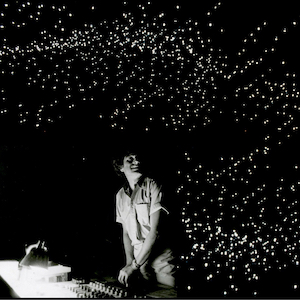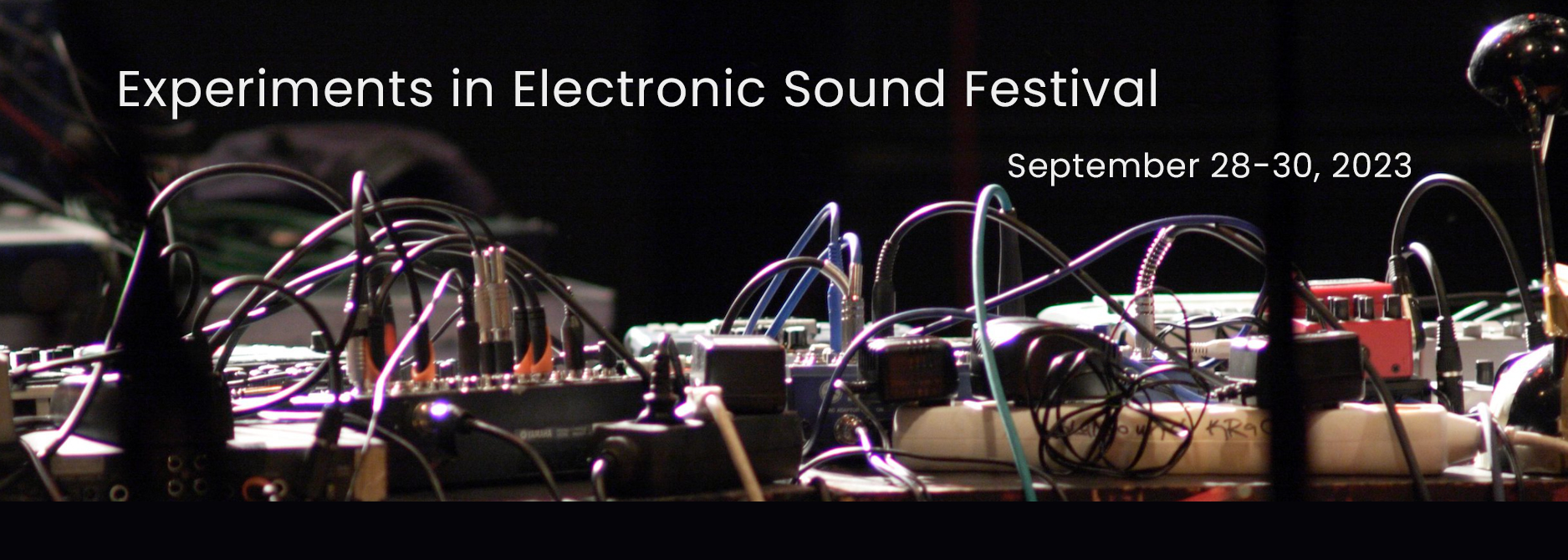Cooper Baker
Cooper was born at Lake Tahoe, California, to artist parents who owned a record store and ran a community theatre. He initially attended conservatory for classical violin performance, but realized he was interested in experimental electronic music, so he transferred to CalArts to finish his BFA in music technology. Cooper stayed for an MFA in experimental composition, and studied with Mark Trayle, Barry Schrader, and Morton Subotnick. After leaving the creative womb of CalArts, Cooper received a Ph.D. from UCSD, where he studied the math and code of signal processing with F. Richard Moore, Tom Erbe, and Miller Puckette. These days, when Cooper isn’t slotted into a wave off the coast of San Diego, he makes a living creating software and hardware for other artists. @docwaveform
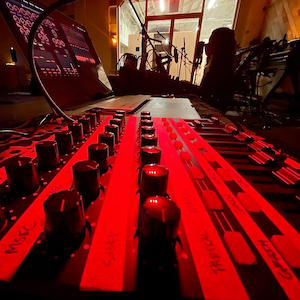
Olivia Block
Olivia Block is a media artist and composer. Currently, her practice includes live performance, recordings, audio-visual installations, sound design, and scores for orchestra and chamber music concerts.
Block’s studio pieces often combine field recordings, electronic sounds, electric organ, piano and long chamber music passages. She composes scores for ensemble, orchestra, pipe organ and piano. Her recordings are published on Another Timbre, Erstwhile, Glistening Examples, NNA Tapes, Room40, Sedimental, and Touch, among other labels. Block performs using various techniques and instruments. She plays improvised and composed pieces on synth organ, laptop, analog synth, amplified objects, inside of grand piano and microphone, among other materials.
Block creates multi-channel diffusion concerts and site-specific, multi- channel sound installations. She recently completed a 14-channel sound installation featuring sounds from Harry Bertoia’s “Sonambient” sculptures
for the Nasher Sculpture Gallery in Dallas, TX. Block has performed, premiered and exhibited her work throughout
Europe, America, and Japan in tours in festivals and performance series including Incubate (Tilburg), MoogFest, Festival del Bosque Germinal (Mexico City), Sonic Light (Amsterdam), Redbull Academy, Kontraste (Krems), Dissonanze (Rome), Archipel (Geneva) and many others. Block has created site specific sound installations for public spaces and exhibition spaces worldwide, including the including Arthur Ross Gallery at University of Pennsylvania, CEAM at Flagler University, MCA Chicago, Moss Arts Center at Virginia Tech, Museo Reina Sofia, and University of Chicago, Manhattan Museum of Arts and Design, Sokolowsko Sanitorium (Poland), CONTEXT (Miami and NY), and The Jay Pritzker Pavilion in Millennium Park (Chicago). She recently completed a 14- channel sound installation featuring sounds from Harry Bertoia’s “Sonambient” sculptures for the Nasher Sculpture Gallery in Dallas, TX.
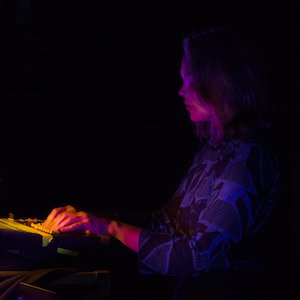
María Bulla and Juan Bermúdez
María Bulla is a music maker. She creates small handmade objects and oversized scores, she makes sounds with a synthesizer and combines them with texts and field recordings; all this with the hope of creating situations that become part of everyday life, that allow people to experience the extraordinary things of life in a personal way.
Juan Bermúdez draws inspiration from the connection between time and sound. His work spans performance, sound installation, painting, and photography. He thinks about time and sound as possessing ephemeral bodies, which are solidified through societal, technological, and political contexts that manifest their presence in space. Juan’s works may occasionally lack sound, but he enjoys exploring the potential of creating soundscapes that inhabit people’s expectations.
María and Juan have been making music together for the past five years, and every summer they create a new piece together. A lot of field recordings from the cities where they have lived manage to find a place in their music. Sometimes they feel like they live in an imaginary place, made from the sounds of Bogotá, Santa Clarita, Mainz, and Ithaca.
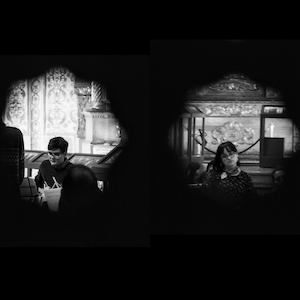
Eliot Burk
Eliot Burk graduated from CalArts with a Performer-Composer MFA in 2022.
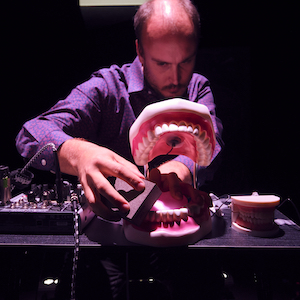
Matt Camgros
Matt Camgros is a percussionist from the San Francisco Bay Area. He attended Sonoma State University, where he studied jazz and improvised music with George Marsh and Doug Leibinger. In 2013, he won First Place in the Sonoma State University International Solo Contest, and was honored by the Sonoma State University Music Department as a Distinguished Graduate in the Field of Jazz. In 2023, he graduated from the University of Washington with a MM in Jazz and Improvised Music, working closely with Cuong Vu and Ted Poor.
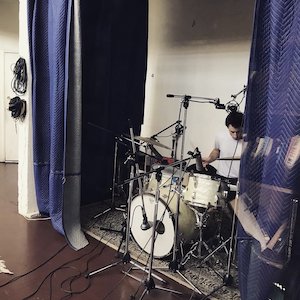
Castle Anthrax
Castle Anthrax is the Los Angeles-based free improvisation trio of Mason Moy (tuba), Matt LeVeque (percussion), and Jack Herscowitz (electronics). Their sounds range from harsh noise to dreamy, ambient textures.
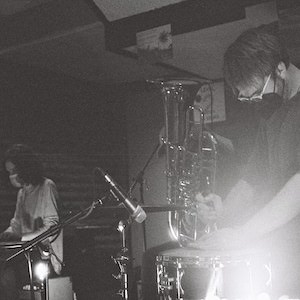
Charles Deluga
Charles Deluga is an audiovisual composer, installation artist, and systems designer exploring the translation of signals across sensory domains. His creative practice combines synthesis, spatial audio, ecoacoustics, and electronics to produce immersive contexts for experiencing the intersection of nature and math. Charles has designed and produced A/V systems for architectural media installations across North America, including the Statue of Liberty Museum and MoMA PS1. He is currently pursuing a PhD in Computer Music at UC San Diego after earning a master’s in Music Technology from New York University.
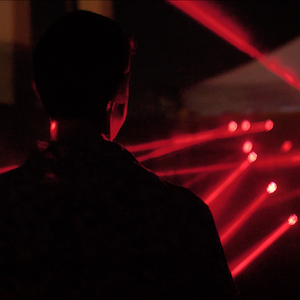
Tim Feeney
Tim Feeney makes sounds and images in forests and waterfronts, investigating unstable sound and duration. He appears in bookstores and basements with Sarah Hennies and Greg Stuart; in galleries and libraries with Vic Rawlings and Annie Lewandowski; in living rooms and warehouses with Clay Chaplin and Davy Sumner; in colleges and museums with Andrew Raffo Dewar, Holland Hopson, and Jane Cassidy; on recordings for Intakt, Black Truffle, Full Spectrum, Sedimental, and Marginal Frequency; and in the occasional festival or concert hall with Anthony Braxton and Ingrid Laubrock. He is the director of the Performer-Composer specialization, and a faculty member in percussion, improvisation, and composition, at the California Institute of the Arts.
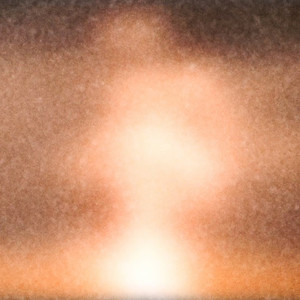
Alex Hawthorn
Alex Hawthorn (b. 1986) (they/them) is an artist, composer, and technologist whose work flows between performance, installation, object-making, and sound-making. As a non-binary interdisciplinary artist, Hawthorn is most comfortable outside prescriptive boxes, allowing their research and intuition to shape the form and medium of their projects. They use their work as a lens through which to investigate the natural world, specifically focusing on time: how we experience it, how we have codified it, and how we exist within it. Their work in theatrical sound design has garnered them an Obie award, LA Ovation Awards, and has been heard across North and South America, Australia, Europe, Asia, Africa, and the Middle East. But most recently they’ve been focusing on writing, coding, and hiking.
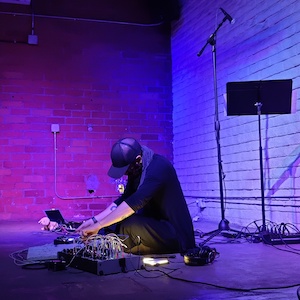
Hermetic Fever
Hermetic Fever is Josh Gerowitz and Louis Lopez, a project inspired by the Hermetic tradition of philosophy, practical magic, potions, and alchemy. Hermetic Fever shared interest in the power of transformation through fermentation, dialectic, and improvisation fuels their musical process.
Joshua Gerowitz is a composer, performer, improviser, and guitarist who resides in Los Angeles. His work is concerned with live human interaction, the juxtaposition of premeditation and spontaneity, as well as the fickle nature of our perceptual senses. He has written and performed music that involves everything from traditional instruments to bottom-shelf beer tastings, knife sharpening, ping pong, and surfing.
Louis Lopez is a performer/composer/engineer working in Los Angeles. His live performances incorporate trumpet, electronics, and custom software that he builds. As a trumpet player, he has performed and recorded with artists Wadada Leo Smith, Mike Keneally, Todd Hannigan, and Twin Temple. He has done sound design for film and television including Patagonia’s films Fish People, Finding Fontinalis, and Takayna. His work as a commercial brass arranger/performer can be heard on ads for Patagonia, Yeti, and other outdoor apparel brands. Louis can be found rebuilding and modifying vintage audio gear and teaching music production at Pasadena City College.
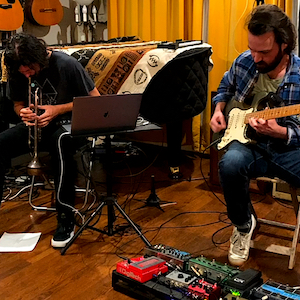
Zaq Kenefick
Zaq Kenefick is an artist located near Long Beach, CA. He is interested in categorization, organization, the implication of the body and blurry things. He teaches preschool and accompanies modern dance.
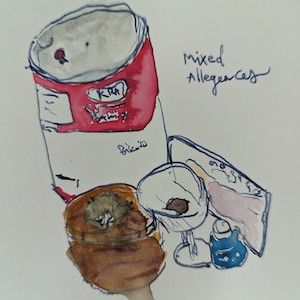
Eric Lennartson
Eric Lennartson is an Oscilloscope Artist, Composer, and Improviser based in Los Angeles. His audio-visual work makes use of analog oscilloscopes, an old piece of electronic testing equipment. While performing, he sends the sounds from his computer directly to the scope and a set of speakers simultaneously. In doing so, sound and image create a feedback loop of meaning. Although sounds create the images, the images have a direct influence on the creation of the sounds. The resulting effect is non objective imagery that interacts with dense noise, pulsating tones, and unstable beats. Through this interaction he explores the intersections between the analog and the digital, as well as the different perspectives and meaning inherent to the sound and image themselves. He has a master’s in Performance and Composition from the California Institute of the Arts and a bachelor’s in Percussion Performance from the University of North Texas. His works have been presented at the Vector Hack Festival in Rijeka Croatia, Music For Your Inbox, The Fuse Factory, and can also be seen as part of an installation at Meow Wolf’s Omega Mart, in Las Vegas.

Matt LeVeque
Matt LeVeque (b.1996) is a percussionist, composer, and improviser based in Los Angeles. Matt has performed at New Music on the Point, the Percussive Arts Society International Convention, BENXT Festival, Yarn/Wire Institute, Darmstädter Ferienkurse, and others. As a composer and researcher, Matt explores through his work aspects of relationality, intimacy, smallness, and duration in pursuit of a politics of queer utopianism. He has presented works via the Transplanted Roots Percussion Symposium, soundpedro, and the Queer Percussion Research Group, among others. Matt is currently pursuing a Performer-Composer D.M.A. at the California Institute of the Arts, where he studies with Tim Feeney, Michael Pisaro-Liu, and Nicholas Deyoe. He holds a B.A. from UC San Diego and an M.F.A. from CalArts.
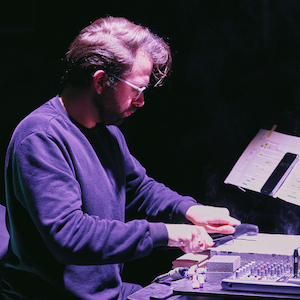
Clare Marie Nemanich
Clare Marie Nemanich is an award-winning theater sound designer and experimental artist who delights in bringing the sounds in their head to life. Recent theater design credits include The Sea Gull at CalArts, Etta and Ella on the Upper West Side at REDCAT and Augustine Machine with CNP in Paris. But that’s not what you came here to read. You want to know how I got the chickens to play music. Buckbeak and Adorasaurus [who perform as BACHBEAK & D(v)ORA(k), Chicken Composers] first learned to peck a dot. This took exactly 7 minutes. A peck on the dot gets a click and a treat to reinforce the behavior–the same way you would train other animals, from dogs to dolphins. From there, I put the dot on peckable instruments. Now, they play dotless. Their repertoire includes xylophone, various string instruments, and piano. Each chicken has instruments she prefers. For more of our work, visit planetclareproductions.com.
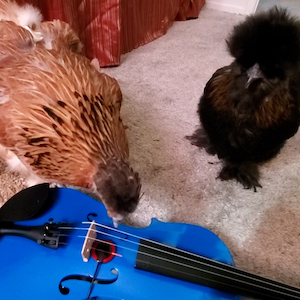
Scott William Perry
Scott William Perry loves to compose music. He earned his PhD in music composition from UCSB in 2019. While at UCSB he won multiple Corwin Awards for Outstanding Composition. He holds a BA from UCSB (CCS), a MFA from California Institute of the Arts, and a MA from UC Davis. He has had his music performed by Scott Worthington, Ensemble Etc., members of the Now Hear ensemble, Kurt Rohde, Viginia Kron, The Ensemble for Contemporary Music, The Wellesley Composer’s Conference Ensemble, The Empyrean Ensemble, and The New Century Players. He has published eight albums of electronic music on https://scottwilliamperry.bandcamp.com/ and is actively seeking a record label to publish them more widely. His teachers include Beverly Grigsby, Jeremy Haladyna, Kurt Rohde, Wolfgang von Schweinitz, Ulrich Krieger, Pablo Ortiz, Mika Pelo, David Rosenboom, Curtis Roads and Clarence Barlow. He has also had lessons and seminars with Mario Davidovsky, Julio Estrada, Michael Pisaro-Liu, and Pauline Oliveros. Scott, who is concerned with wellness in general for himself and all humankind, also practices in the Kagyu Lineage of Vajrayana Buddhism.
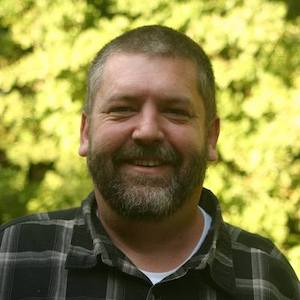
(placeHolder)
What is (placeHolder)? We don’t really know. One fateful night, in the Fall of 2020, M A Harms, Eric Lennartson, and Daniel Newman-Lessler put together a house show in Somis, CA. Unbeknownst to them, that singular event would spark lifelong friendships and lots and lots of music. Sometimes it’s a soft and simple droning on pump organs accompanying folk melodies; other times it is a fury of feedback and rogue electronics; frequently it is an eruption of a joyous cacophony; and always it is something new, unexpected, and a complete departure from previous performances.
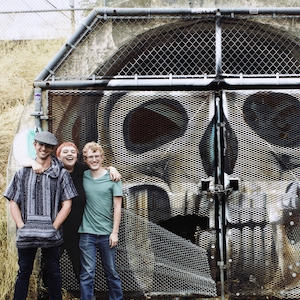
Alessandro Rovegno
Alessandro Rovegno is a composer, sound artist, and improviser currently based in Los Angeles, CA. His work is rooted in an innermost relationship with the act of Listening: allowing the emergent phenomenological, emotional, and spatial revelations from his listening practice to inform the structural and aesthetic manifestations of his pieces. This is often explored through gradual manipulation of tone, timbre, and mood over long durations– in both acoustic and electronic mediums. His compositions weave together field recordings, synthesis, sampled materials, and acoustic sounds to create a layered sonic environment. Rovegno’s work operates on the edge of perceptibility– where he invites the listener to engage with their own listening practice in an intimate and devoted manner. Rovegno holds a BM with a focus in Composition from Cornish College of the Arts, where he studied with Tom Baker and Jarred Powell. He is currently pursuing an MFA in Composition and Experimental Sound Practices from the California Institute of the Arts studying with Michael Pisaro-Liu.
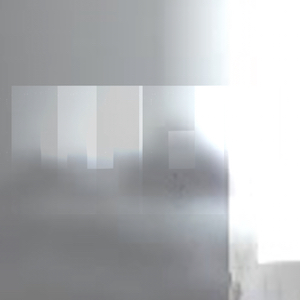
Drew Sensue-Weinstein
Drew Sensue-Weinstein (he/him) is a sound and stage artist who creates work that exist along a continuum of music and theatrical performance. Drew’s music is multifaceted and spans a variety of genres. A trained guitarist with a background in ambient music and extreme metal, Drew’s recent pieces revolve around his Field Recording practice. This music centers sound recorded from a variety of environments and explores them in a dramaturgically rigorous capacity which crosses paths with ecological research, personal memory, pitched instrumentation, electronics, spoken word, and ambient screaming. Drew currently lives in Los Angeles and recently completed an MFA in Composition and Experimental Sound Practice at California Institute of the Arts. Before CalArts, Drew spent nearly a decade in New York City where he worked as a theatre sound designer and director. He has designed and composed music for companies including LEIMAY, HERE Arts Center, the Oye Group, the Brick, Taragano Theatre, Refracted Theatre Company, Quantum Theatre (Pittsburgh, PA), the Shakespeare Theatre of New Jersey, Corkscrew Theatre Festival, and many more.
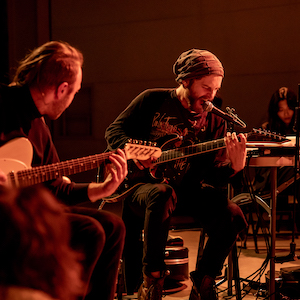
Squash & Biscuit
Squash & Biscuit 瓜和饼干 is Shuwen Zhao and Brian Griffith. Based in Los Angeles, they create strange structured improvisations for their personal expression, compose soundscape experiments for choreographed movement, and design musical scores along with sound for animations and film.
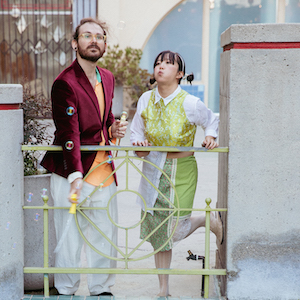
Karlheinz Stockhausen
A major composer of the second half of the twentieth century, Karlheinz Stockhausen, after studying at Cologne University (1948-1951), encountered Pierre Boulez at the Darmstadt classes and also Olivier Messiaen with whom he studied in 1952. From 1953 he worked at the studio of Radio Cologne and established the foundations of electronic music. A creative artiste in perpetual renewal, he explored the most innovative paths of musical research: serialism, aleatory and intuitive music, spatialisation and the liberation of time. With live electronic treatment, he created an unprecedented sound world and was open to the mysticism of cosmic music.
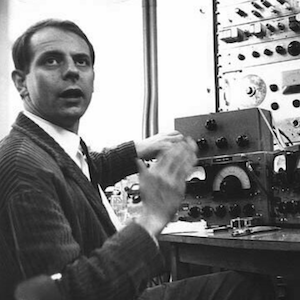
Breana Tavagilone
Composer/sound artist Breana Tavaglione utilizes composition as a means to paint with sound, creating an immersive sensory experience in which she deconstructs conceptual themes in order to convey a specific mood or aesthetic, transporting listeners to an alternative sonic landscape. She graduated in 2018 from California Institute of the Arts with a MFA Experimental Sound Practices, and in 2016 from Mills College with a BA in Music Composition with an Emphasis in Media Technology and Electronic Music. She is a PhD candidate in Digital Arts and Experimental Media (DXARTS) at the University of Washington, working under the guidance of Richard Karpen.
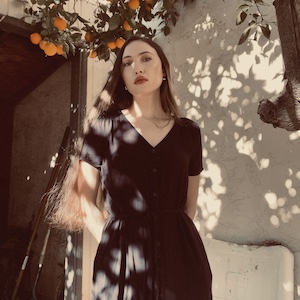
Terminal Moraine
Terminal Moraine is an experimental noise duo founded by Abigail Johnson and Andrew Dyet in 2020. They perform improvisations guided by graphic scores, time constraints, or predetermined restrictions. They have been featured as an Ensemble in Residence for the Re:Sound Festival 2023 in Cleveland, OH and as artists-in-residence for the 2022 Chateau Orquevaux Artist Residency in Orquevaux, France. Abigail and Andrew completed their MFA in Experimental Sound Practices in 2021.
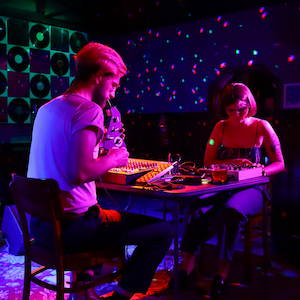
James Thomer
James Thomer is an LA-based composer/performer, writer/director, and intermedia artist. He has a BA in English from UC Berkeley and an MFA in Composition & Experimental Sound Practices from the California Institute of the Arts.
His intermedia work often plays with notions of the real, fake, and the uncanny. In this work, he is interested in creating alternate realities, fake stories, and distortions of history, combining creative writing, video, and media art within the backdrop of his musical experience.
In his recent music, he is interested in breaking down his own practice as a composer, songwriter and performer, looking for new ways to explore genre and form. He explores the chameleonic fluency of style that exists in his repertoire as a modern musician, and thinks of how music exists in new contexts, such as in film, media, or collective understanding.
He produces and performs under his art rock/psych pop project “James The Fifth” and released his debut LP Days of Wine in 2022 on Mutation Records (US) and Tearjerk Records (Aus). He has toured in the western United States and frequently performs as a guitarist with bands in Los Angeles.
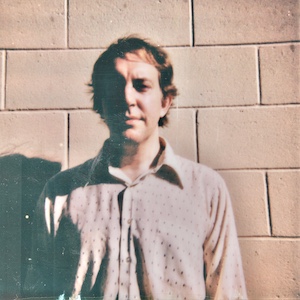
Fabricio Watanay
Fabricio is a composer from Cusco, Peru who synthesizes composition, performance, pedagogy, and investigation in his musicianship. As a musician, he approaches diverse musical languages between traditional Andean, popular, experimental, and academic music. His musical education has passed through diverse stages in America (the Continent), where he also participates in ancestral Andean festivities, especially as a Ukuko of the Paucartambo Nation in the yearly pilgrimage to the Lord of Coyllority. In Texas, He attended TCU for his bachelor’s in string performance (2012) and SMU for his master’s in Music Composition and Theory (2015). He learned to replicate and experiment with pre-Columbian musical instruments made of clay at the UNTREF in Buenos Aires, Argentina, where he also became a member of the Orchestra of Autochthonous Instruments and New Technologies, directed by Alejandro Iglesias Rossi. Since 2022, he has incorporated these experiences as a doctoral student in the Integrated Composition, Improvisation, and Technology Ph. D. program at the University of California Irvine.
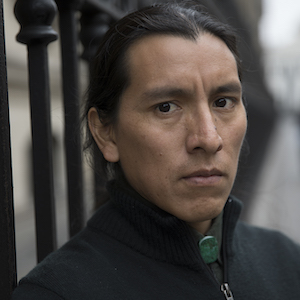
Hildegard Westerkamp
Hildegard Westerkamp was born in Osnabrück, Germany in 1946 and emigrated to Canada in 1968. After completing her music studies in the early seventies Westerkamp joined the World Soundscape Project under the direction of Canadian composer R. Murray Schafer at Simon Fraser University (SFU) in Vancouver. She is a founding member and is currently active on the board of the World Forum for Acoustic Ecology (WFAE). Between 1991 and 1995 she was the editor of The Soundscape Newsletter and is now on the editorial committee of Soundscape -The Journal of Acoustic Ecology, a new publication of the WFAE.
By focusing the ears’ attention to details both familiar and foreign in the acoustic environment, Westerkamp draws attention to the inner, hidden spaces of the environment we inhabit. The majority of her compositional output deals with aspects of the acoustic environment: with urban, rural or wilderness soundscapes, with the voices of children, men and women, with noise or silence, music and media sounds, or with the sounds of different cultures, and so on. She has composed film soundtracks, sound documents for radio and has produced and hosted radio programs.
Her compositions have been performed and broadcast in many parts of the world. In 1998, she co-created Nada, an installation about listening at the Indira Gandhi National Centre for the Arts Janpath, in collaboration of Savinder Anand, Mona Madan, and Veena Sharma. Leading up to this, she conducted soundscape workshops at Max Mueller Bhavan in New Delhi in 1992, 1994 and 1997.
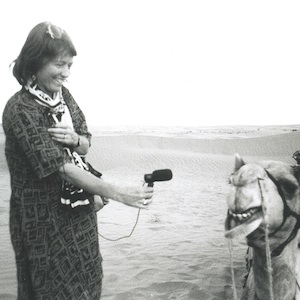
Iannis Xenakis
Iannis Xenakis (1922-2001) was a Greek-French architect, composer, engineer and mathematician. He is considered one of the most influential and innovative composers in the 20th century. His works range from electronic and instrumental music to architectural designs and multimedia works.
Xenakis was born into a wealthy Greek family in Romania and from an early age his life was marked by adversity and displacement. His family fled from Romania due to political instability and finally settled in Greece, where Xenakis studied Engineering at the Athens Polytechnic Institute. He joined the Greek resistance during World War II and was seriously injured. He lost his left eye due to an explosion, an experience which had a profound effect on his life and artistic work.
After the war, Xenakis moved to Paris where he worked in Le Corbusier’s architecture studio and attended Olivier Messia’s composition classes, who encouraged him to explore the use of mathematics in musical composition. His early and highly innovative works “Metastasis” (1953-54) and “Pithoprakta” (1955-56) created a unique sound world that defied traditional music conventions.
In addition to his work as a composer, Xenakis was also a brilliant architect. He worked on projects like the Philips Pavilion at the 1958 World Fair in Brussels and designed buildings that were both functional and aesthetically innovative.
Throughout his career, Xenakis continued creating powerful aesthetically defying works. When he died in Paris on 4th February, 2001 he left behind a rich and influential legacy which continues to inspire architects and musicians to this day.
